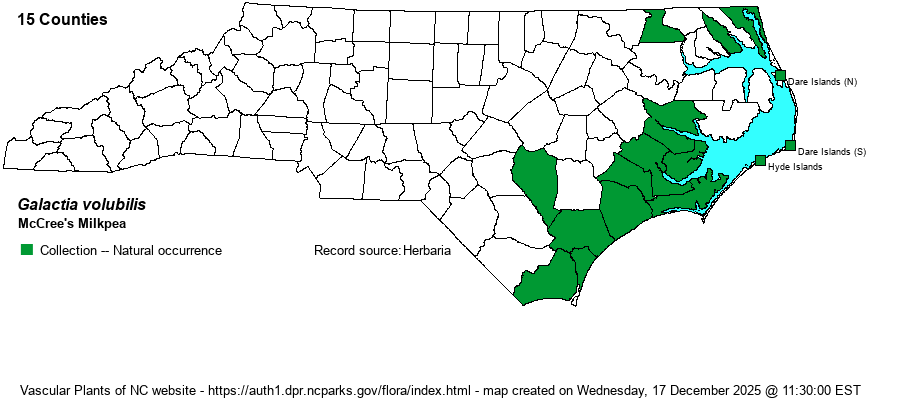| Author | (L.) Britton | |
| Distribution | This species is what used to be called G. macreei, which in many older references and manuals was lumped into G. volubilis in the "old" and broad sense. G. volubilis in the "new" sense is most often found in NC in maritime and near-maritime situations, and much less numerous farther inland, perhaps just west to Hertford and Sampson counties.
This is a mostly Coastal Plain species, ranging north to southeastern VA, and south to southern FL and west to eastern TX. | |
| Abundance | Infrequent (to perhaps locally numerous on the Outer Banks) in coastal counties, and seemingly quite rare farther inland. The status is not clear, as this taxon has been variously lumped into another species and from species to species (name changes). The editors suggest S3? for now. | |
| Habitat | This is a species of dry to mesic sandy shrublands on dunes and interdunes, woodland borders, and sandy clearings. | |
| Phenology | Blooms fairly early for a Galactia, from May to August, and fruits from July to October. | |
| Identification | This is usually a strongly climbing vine that can reach 4-5 feet long. The stem has some hairs, and these may be backward slanting (retrorse) hairs, but it is not as villous/hairy as stems of G. regularis. The 3 leaflets of G. volubilis are somewhat differently shaped from those of G. regularis; they are ovate to lanceolate and about 1 inch long and notably narrower, but the widest part of the leaflet is just below the midpoint, toward the base. The leaflets of G. volubilis are somewhat thin in texture, as opposed to somewhat thick in the other. Also, Nesom (2015) notes that the undersides of the leaflets of this species are mostly glaucous (whitish). Lastly, G. volubilis has relatively large flowers; the rose to pink flowers are nearly 1/2-inch across (9-14 mm), as opposed to just 1/3-inch (7-10 mm) in G. regularis. Sorrie (2011) notes that in this species the standard (the large, top petal) is spread back such that the open flower is about "flat" (180 degrees); the flowers of G. regularis have the standard spread only about 90 degrees from the lower petals. Observers in the tidewater region will run into this milkpea often in their walks in drier habitats. Be careful of the identifications, as other species do occur there. | |
| Taxonomic Comments | The former G. macreei was considered as a part of this larger species by many references.
| |
| Other Common Name(s) | Weakley (2024) names this as McCree's Milkpea, to avoid confusion. The old G. volubilis, now G. regularis, was named as Downy Milkpea, but is now named as Eastern Milkpea. The former G. macreei has stems with some retrorse hairs and is not overly downy, and thus is our preferred name. | |
| State Rank | S4 [S3?] | |
| Global Rank | G5 | |
| State Status | | |
| US Status | | |
| USACE-agcp | FACU link |
| USACE-emp | FACU link |

